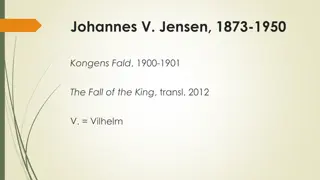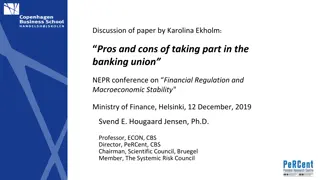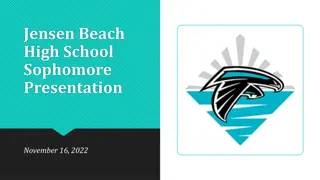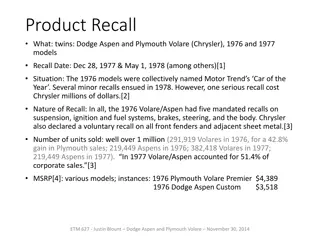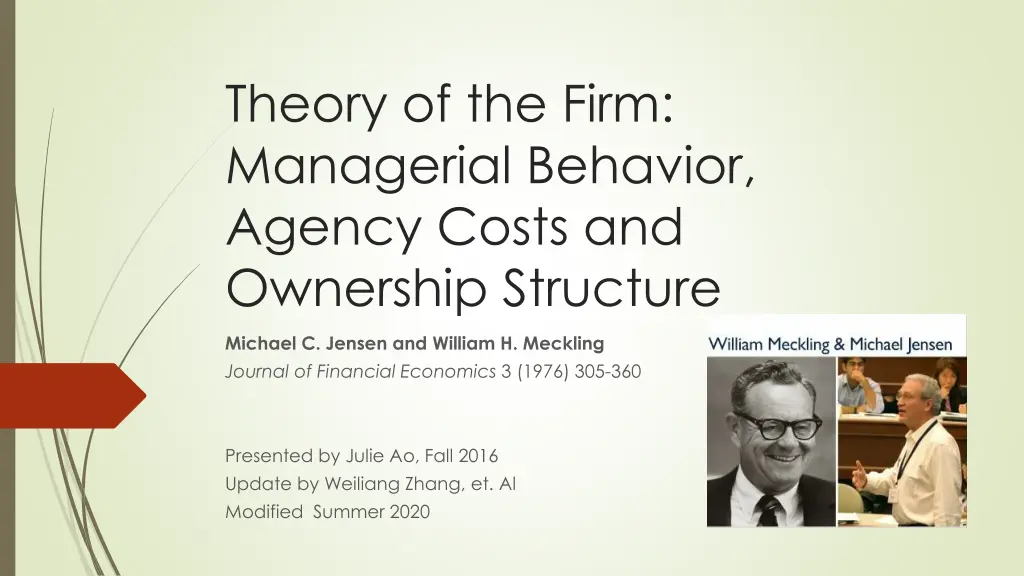
Theory of Firm Ownership Structure: Jensen & Meckling 1976
Explore the seminal work of Michael C. Jensen and William H. Meckling on the theory of firm ownership structure, focusing on agency costs, managerial behavior, and finance. Learn how agency costs, debt, and equity influence ownership structure and decision-making within organizations.
Download Presentation

Please find below an Image/Link to download the presentation.
The content on the website is provided AS IS for your information and personal use only. It may not be sold, licensed, or shared on other websites without obtaining consent from the author. If you encounter any issues during the download, it is possible that the publisher has removed the file from their server.
You are allowed to download the files provided on this website for personal or commercial use, subject to the condition that they are used lawfully. All files are the property of their respective owners.
The content on the website is provided AS IS for your information and personal use only. It may not be sold, licensed, or shared on other websites without obtaining consent from the author.
E N D
Presentation Transcript
Theory of the Firm: Managerial Behavior, Agency Costs and Ownership Structure Michael C. Jensen and William H. Meckling Journal of Financial Economics 3 (1976) 305-360 Presented by Julie Ao, Fall 2016 Update by Weiliang Zhang, et. Al Modified Summer 2020
2 Background Michael C. Jensen: He was LaClare Professor of Finance and Business Administration at the William E. Simon Graduate School of Business Administration, University of Rochester from 1984-1988. Now he is a professor at Harvard Business School, emeritus. William H. Meckling: He was the dean emeritus of the Simon Business School, University of Rochester. He passed away in 1998. According to Google Scholar, the article has been cited over 75,000 times since 1976 in journals on topics as diverse as business, management, accounting, economics, econometrics, finance, decision sciences, and psychology.
Motivation and Objective 3 Objective of the article is to develop a theory of ownership structure for the firm drawing on (1) property rights theory, (2) agency theory, and (3) finance theory. Jensen and Meckling (1976): (a) define the concept of agency costs, and show its relationship to the separation and control issue; (b) investigate the nature of the agency costs generated by the existence of debt and outside equity; and (c) demonstrate who bears these costs and why. Jensen and Meckling (1976) also provide a new definition of the firm, and show how their analysis of the factors influencing the creation and insurance of debt and equity claims.
The Content of the Article: 4 Introduction The Agency Cost of Outside Equity Some unanswered questions regarding the existence of the corporate form The Agency Cost of Debt A Theory of Corporate Ownership Structure Qualifications and extensions of the analysis Conclusions
The Key Dilemma Other Peoples Money 5 Economics is just side remarks to ideas presented by Adam Smith: The directors of such [joint-stock] companies, however, being the managers rather of other people s money than of their own, it cannot well be expected, that they should watch over it with the same anxious vigilance with which the partners in a private copartnery frequently watch over their own. Like the stewards of a rich man, they are apt to consider attention to small matters as not for their master s honour, and very easily give themselves a dispensation from having it. Negligence and profusion, therefore, must always prevail, more or Iess, in the management of the affairs of such a company. The Wealth of Nations, 1776, Cannan Edition (Modern Library, New York, 1937) p. 700.
Objectives: 6 This paper integrates elements from the theory of agency, the theory of property rights and the theory of finance to develop a theory of the ownership structure of the firm. We define the concept of agency costs, show its relationship to the separation and control issue, investigate the nature of the agency costs generated by the existence of debt and outside equity, demonstrate who bears these costs and why, and investigate the Pareto optimality of their existence. We also provide a new definition of the firm, and show how our analysis of the factors influencing the creation and issuance of debt and equity claims is a special case of the supply side of the completeness of markets problem.
Motivation of the paper 7 The theory helps explain: why an entrepreneur or manager in a firm which has a mixed financial structure (containing both debt and outside equity claims) will choose a set of activities for the firm such that the total value of the firm is Iess than it would be if he were the sole owner and why this result is independent of whether the firm operates in monopolistic or competitive product or factor markets; why his failure to maximize the value of the firm is perfectly consistent with efficiency; why the sale of common stock is a viable source of capital even though managers do not literally maximize the value of the firm; why debt was relied upon as a source of capital before debt financing offered any tax advantage relative to equity; why preferred stock would be issued;
Motivation of the paper (2) The theory helps explain: 8 why preferred stock would be issued; why accounting reports would be provided voluntarily to creditors and stockholders, and why independent auditors would be engaged by management to testify to the accuracy and correctness of such reports; why lenders often place restrictions on the activities of firms to whom they lend, and why firms would themselves be led to suggest the imposition of such restrictions; why some industries are characterized by owner-operated firms whose sole outside source of capital is borrowing; why highly regulated industries such as public utilities or banks will have higher debt equity ratios for equivalent levels of risk than the average non-regulated firm; why security analysis can be socially productive even if it does not increase portfolio returns to investors.
9 Theory of the Firm Actually, the article is not a theory of the firm per se, but rather is a theory of markets in which firms are important actors. We have no theory that explains how the conflicting objectives of the individual participants are brought into equilibrium so as to yield this result of a firm. The firm is a black box operated so as to meet the relevant marginal conditions with respect to inputs and outputs. The limitations of this black box, neoclassical view of the firm have been cited by Adam Smith and Alfred Marshall, among others.
10 Property Rights What is important for the problems addressed here is that specification of individual rights determines how costs and rewards will be allocated among the participants in any organization. Specification of rights is generally achieved through contracting, individual behavior in organizations, including the behavior of managers. Jensen and Meckling (1976) focus on the behavioral implications of the property rights specified in the contracts between the owners and managers of the firm.
Agency Costs 11 Agency relationship: A contract under which one or more persons (principal) engage another person (agent) to perform some service on their behalf which involves delegating some decision making authority to the agent. If the contractual parties to the relationship are utility maximizers, there is good reason to believe that the agent will not always act in the best interests of the principal. Agency costs are the sum of: The monitoring expenditures by the principal, The economic bonding expenditures by the agent, The residual loss
Agency costs re-explained 12 The principal can limit divergences from his interest by establishing appropriate incentives for the agent and by incurring monitoring costs designed to limit the aberrant activities, of the agent. In addition in some situations it will pay the agent to expend resources (bonding costs) to guarantee that he will not take certain actions which would harm the principal or to ensure that the principal will be compensated if he does take such actions. However, it is generally impossible for the principal or the agent at zero cost to ensure that the agent will make optimal decisions from the principal s viewpoint.
Definition of the Firm 13 Coase (1937): Boundary of the firm is the range of exchanges over which the market system is suppressed and resource allocation is accomplished by authority and direction Alchian and Demsetz (1972): Emphasis on role of contracts as a vehicle of voluntary exchange Jensen and Meckling s (1976) definition: Most organizations are simply legal fictions which serve as a nexus for a set of contracting relationships among individuals.
Agency Costs of Equity---Overview 14 If a wholly owned firm is managed by the owner, he will make operating decisions which maximize his utility. The inclusion of outside equity will generate agency costs due to divergence of interests since the principal will then bear only a fraction of the costs of any non-pecuniary benefits he takes out in maximizing his own utility. A Simple Formal Analysis
Model assumptions 15 Permanent assumptions All taxes are zero. No trade credit is available. All outside equity shares are non-voting. No complex financial claims such as convertible bonds or preferred stock or warrants can be issued. No outside owner gains utility from ownership in a firm in any way other than through its effect on his wealth or cash flows. All dynamic aspects of the multiperiod nature of the problem are ignored by assuming there is only one production-financing decision to be made by the entrepreneur. The entrepreneur-manager s money wages are held constant throughout the analysis. There exists a single manager (the peak coordinator) with ownership interest in the firm.
Model assumptions (2) 16 Temporary assumptions The size of the firm is fixed. No monitoring or bonding activities arc possible. No debt financing through bonds, preferred stock, or personal borrowing (secured or unsecured) is possible. All elements of the owner-manager s decision problem involving portfolio considerations induced by the presence of uncertainty and the existence of diversifiable risk are ignored.
No monitoring cost & Fixed the size of firm V: value of the firm F: manager s expenditures on non- pecuniary benefit U: indifference curve of the manager VF: budget constraint : fraction of manager s equity
V D FIRM VALUE AND WEALTH V* A U1 Slope = - U2 B V U3 V0 Slope = - Slope = -1 F 0 F* F0 F
Agency Costs of Equity 19 Suppose the owner sells a share of the firm, 1- , and retains for himself a share, Simple Formal Analysis D A: If the owner-manager is free to choose the level of perquisites, his welfare will be maximized by increasing his consumption of non-pecuniary benefits When the owner has 100% of the equity If the manager could choose whatever level of non- pecuniary benefits he liked Value of the firm A B: If the owner has decided to sell a claim 1- of the firm, his welfare will be maximized Tradeoff the owner- manager faces between non- pecuniary benefits and his wealth after the sale Theorem: For a claim on the firm of (1- ) the outsider will pay only (1- ) times the value he expects the firm to have given the induced change in the behavior of the owner- manager
D: optimal set between non-pecuniary and firm value B: the final set when the fraction of outside equity is(1- ) V: V* V0 V F: F* F0 F For a claim on the firm of (1- ) the outsider will pay only (1- )V when he expect the firm to have given the induced change in the behavior of the owner- manager. W = S0 + Si = S0 + V(F, ) = S0 + V = (1- )V + V = V
Determination of the optimal scale of the firm W : initial pecuniary wealth I : access to a project requiring investment outlay A : the gross agency cost
W+[V(I*)-I*] Expansion path with 100% ownership by manager C W+V*-I* CURRENT DOLLARS A D W+V -I Slope = - Expansion path with fractional ownership by manager F F* Slope = -1 MARKET VALUE OF THE STREAM OF MANAGER S EXPENDITURESON NON-PECUNIARY BENEFITS
The role of monitoring activities in reducing agency cost M : the optimal monitoring expenditure of the outside ( for this case: distance between C & D) BCE : the opportunity set as the tradeoff constraint facing by the owner V = V F(M, ) - M
V FIRM VALUE AND WEALTH V* U1 D M C V U2 E B V U3 Slope = - Slope = -1 F F F 0 F* MARKET VALUE OF MANAGER S EXPENDITURES ON NON-PECUNIARY BENEFITS
Expansion path with monitoring and bonding activities P1: Expansion path with 100% ownership by manager P2 : Expansion path with fractional managerial ownership but no monitoring or bonding activities P3 : Expansion path with fractional managerial ownership and monitoring and bonding activities
W+[V(I*)-I*] P1 C P3 W+V*-I* CURRENT DOLLARS G v W+V -I D P2 F F F* F MARKET VALUE OF THE STREAM OF MANAGER S EXPENDITURESON NON-PECUNIARY BENEFITS
Agency Costs of Equity 27 Optimal Scale of the Firm in the Presence of Monitoring and Bonding Activities The existence and size of the agency costs depends on the nature of the monitoring costs, the tastes of managers for non-pecuniary benefits and the supply of potential managers who are capable of financing the entire venture out of their personal wealth Optimum point
v = W + V I M M = m + b m : cost of monitoring activities b : cost of bonding activities A(m, b, , I) = ( V* - I* ) ( V I M ) A is agency costs;
The Agency Costs of Debt 29 Why don t we observe large corporations individually owned with a tiny fraction of the capital supplied by the entrepreneur in return for 100% of the equity and the rest simply borrowed? Reasons: 1) The incentive effects associated with highly leveraged firms Strong incentive to engage in activities (investments) which promise very high payoffs if successful even if they have averylow probability of success. Issuance of debt generates agency costs, which are the responsibility of the owner-manager 2) The monitoring costs these incentive effects engender Manager is likely to incur bonding costs to reduce effects of internal and external monitoring costs 3) Bankruptcy costs Operating costs and revenues of a firm are adversely affected
30 In general if the agency costs engendered by the existence of outside owners are positive it will pay the absentee owner (shareholders) to sell out to an owner-manager who can avoid these costs. In summary, the agency costs associated with debt consist of: 1)The opportunity wealth loss caused by the impact of debt on the investment decisions of the firm 2)The monitoring and bonding expenditures by the bondholders and the owner-manager (the firm) 3)The bankruptcy and reorganization costs
Theory of the Corporate Ownership Structure 31 Jensen and Meckling (1976) use the term ownership structure rather than capital structure to highlight the fact that the crucial variables to be determined are not just the relative amounts of debt and equity but also the fraction of the equity held by the manager.
Theory of the Corporate Ownership Structure 32 Total agency costs associated with the exploitation of the outside equity holders by the owner-manager Total agency costs associated with the presence of debt in the ownership structure Total agency cost (1) As long as capital markets are efficient the prices of assets such as debt and outside equity will reflect unbiased estimates of the monitoring costs and redistributions which the agency relationship will engender (2) The selling owner-manager will bear these agency costs Thus, from the owner-manager s standpoint the optimal proportion of outside funds to be obtained from equity (versus debt) for a given level of internal equity is that E which results in minimum total agency costs.
AT(E*,K,V*) A*T(K,V1*) Total agency cost AT(K,V0*) 0 K Total agency costs as a function of the fraction of the firm financed by outside claims for two firm sizes, V1* > V0*
Risk and the demand for outside financing The owner-manager will invest 100% of his personal wealth in the firm, and then resort to outside financing, but in fact he allocate his wealth in diversified ways to reduced the risk. So when he want to reduce this cost he will bear some agency cost( from the issuance of equity and debt)
Optimal amount of outside financing, K* demand for outside financing Marginal agency cost: K AT(E*,K,V*) K* 1.0 K Fraction of firm financed by outside claims
Monitoring and the social product of security analysts A large body of evidence exist which indicates that security prices incorporate in an unbiased manner all public available information and much of what might be called private information. Furthermore, the security analysis activities will reduce the agency costs associated with the separation of ownership and control they are indeed social productive.
Key Findings / Results 38 Agency costs are non-zero Finding that agency costs are non-zero (i.e., that there are costs associated with the separation of ownership and control in the corporation). The size of the divergence (the agency costs) will be directly related to the cost of replacing the manager. The existence and size of the agency costs depends on the nature of the monitoring costs, the tastes of managers for non-pecuniary benefits and the supply of potential managers who are capable of financing the entire venture out of their personal wealth. If monitoring costs are zero, agency costs will be zero or if there are enough 100 percent owner-managers available to own and run all the firms in an industry (competitive or not) then agency costs in that industry will also be zero. The agency costs associated with debt consist of: the opportunity wealth loss caused by the impact of debt on the investment decisions of the firm, the monitoring and bonding expenditures by the bondholders and the owner-manager (i.e., the firm), the bankruptcy and reorganization costs.
Conclusions 39 Objectives and results Jensen and Mecking s article is not just about agency costs, as it is mostly known. It s a highly interesting theoretical article about the theory of the firm and ownership aspect of the firm Although the paper is one of the most cited articles of finance, it still needs more in-depth analysis to be understood right. It s objectives were: To integrate elements from the theory of agency, the theory of property rights and the theory of finance to develop a theory of the ownership structure of the firm. (IT DID) Define the concept of agency costs, show its relationship to the separation and control issue, investigate the nature of the agency costs generated by the existence of debt and outside equity, demonstrate who bears these costs and why, and investigate the Pareto optimality of their existence. (IT DID) Provide a new definition of the firm, and show how our analysis of the factors influencing the creation and issuance of debt and equity claims is a special case of the supply side of the completeness of markets problem. (ID DID)













